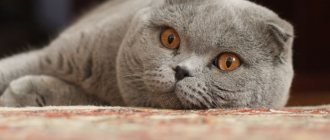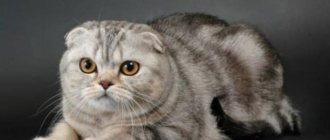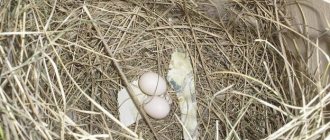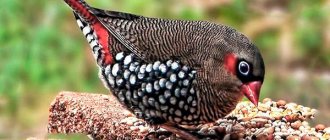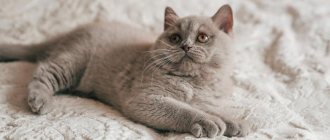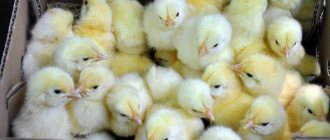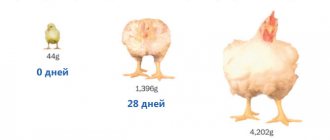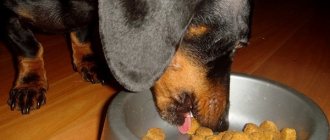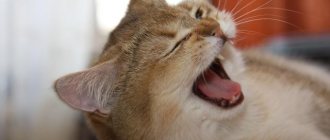Proper feeding and care of a Scottish Fold kitten is the key to the proper growth and development of a purebred pet. Scottish cats, like their relatives of the British breed, are unpretentious in maintenance and care. But the diet must be balanced, because the Scots are prone to a congenital disease in which degenerative processes are observed in the osteochondral system.
Breed Features
Scottish cats come in short-haired, long-haired (Highland), straight-eared (Straight) and fold-eared (Fold). This breed has its own characteristics. For example, a genetic disease that affects every fifth representative of the breed is osteochondrodysplasia of Scottish fold cats. It appears only in folds if both parents of the animal are fold-eared. Therefore, when choosing a fold-eared kitten, you should pay attention that one parent is straight-eared, and the other is fold-eared.
Fold-eared and straight-eared varieties of the breed
Unscrupulous breeders strive to cross two fold-eared cats so that all the kittens in the litter have floppy ears, that is, folds. However, a kitten born from such a union is disabled, suffers from constant pain and is unlikely to live more than three years.
The disease manifests itself as a pathology of the musculoskeletal system. With age, growths appear on the joints and bones of the limbs, which cause pain to the animal. Even an inexperienced cat owner can identify the disease at a young age by its unnaturally short legs and tail.
Also, when choosing a fold-eared variety of Scottish cat, you need to pay attention to the bend of the ears of the fold-eared parent. If he is not very strong, a kitten's lop ears may straighten out over time.
A good curl of the ears of a Scottish cat
Scratching post and toys
Mandatory care attributes that any Scottish kitten should have are:
- one or two scratching posts that will allow you to sharpen your claws and clean them in a timely manner - as the basis of care;
- various types of toys in the form of balls, mice, fishing rods with feathers and other entertaining toys that you and your pet will enjoy.
Having these toys will not only amuse your animal, but will also allow him to have fun while you are away. And if you wish, you can always play with your pet without thinking about where to get a ribbon for playing or a candy wrapper in order to attract a Scottish kitten.
© shutterstock
Animal hygiene
The most important aspect of caring for a Scottish cat is eye, ear and coat hygiene. Due to the characteristics of the breed, it is worth learning in advance how to care for a fold-eared kitten and an adult animal.
Eyes
Scottish fold cat (Scottish fold)
Scots have a short, flat muzzle, so leaky eyes are a common problem for them. Normally, tears, moistening the eye, should flow into the nasolacrimal duct. In Scots, due to their short muzzle, the nasolacrimal duct is deformed or completely closed, so the eye can constantly water. Tear fluid overflows over the edge of the eyelid, and smudges appear on the face.
Important! You cannot use tea leaves to wash your eyes, as the tea leaves contain microorganisms that can contribute to the development of pathogenic flora in the eyes.
If your pet has this problem, the best solution is to use a special eye wash lotion, boiled water or aqueous chlorhexidine.
Nail trimming
Some Scottish cats have claws that grow uncontrollably. Normally, when using a scratching post, the cat removes the top layer of its claws, grinding them down. But many Scots neglect the scratching post. And if an ordinary cat needs to trim its claws only when necessary, then you need to take better care of the Scots’ paws. Otherwise, the claw bends and digs into the paw pad with its sharp part, causing pain to the animal.
To properly trim a Scotsman's claws, you need to press the cat's finger from above - then the claw will “come out” of the paw, and cut off its tip to the pink border. If you accidentally touch the pink part of the claw, you can damage the vessel.
Important! To stop bleeding, hydrogen peroxide or potassium permanganate in powder form is used.
How to trim claws correctly
When to bathe and how
You can wash your cat only if there is an urgent need for it. For example, if the animal is very dirty in something or is unable to wash itself.
To wash your cat you need to use special shampoos for animals. Before washing, the shampoo must be diluted in water, whipped into foam and washed with this foam. Usually cats are against such procedures, so it is better to wash the animal with an assistant.
Ear cleaning
Wax that forms in the ears is normally expelled when the cat moves its jaw. That is, ears require cleaning only if they are very dirty. But a variation of the Scottish breed - fold-eared cats - sometimes accumulates excess sulfur and needs to be cleaned out.
Note! You cannot put ear sticks into your ear. Unknowingly, you can damage the ear canal.
It is best to use special lotions to clean your ears. It is necessary to drop a few drops into the ear, massage the auricle at the base and give the cat a good shake of the head. Next, simply clean the outer part of the ear with a damp cotton pad and repeat the procedure with the second ear.
Grooming
A cat that lives in an apartment and is warm all year round can shed constantly. There is no pathology in this, it’s just that the cat’s body does not grasp the system of changing seasons.
Due to permanent shedding, a cat's fur requires constant brushing. If this is not done, tangles may form that cannot be removed with a comb. For combing at home, it is best to use a furminator. It makes it much easier to remove excess hair.
Furminator for combing
For express shedding, you can contact a groomer. The cat groomer will properly comb the cat and tell you how to care for its fur. Groomers also offer a service such as grooming Scottish cats. Before deciding to clip, you should weigh the pros and cons, because this procedure brings a lot of stress to animals.
Important! Dry air can also lead to constant heavy shedding. In this case, a humidifier will help out.
On a note
Owners of this breed note that the Scottish cat is quite calm and balanced and can spoil or do some kind of mischief only if the owners do not adhere to a sufficient level of cleanliness and care and do not provide everything necessary for the pet’s life.
© shutterstock
An integral part of the care is also a planned, independent examination of the ears and eyes, timely trimming of nails and comprehensive care for the pet’s coat, as well as a visit to the veterinarian for vaccination and carrying out all necessary procedures according to the schedule.
Organization of a sleeping place
Scottish fold cat: character, breed description
Scots, like all cats, love secluded places, boxes and cozy baskets. For the comfort of your pet, you can purchase a special cat house in a pet store, which has a shelter, a scratching post and ladders along which you can climb from level to level.
Also, the cat will not mind sleeping next to its owner. If the owners are not satisfied with this, it is necessary to wean the Scot from resting on the bed from a very young age.
Adaptations
Brushes for combing are:
- wooden and plastic;
- with wide teeth or natural bristles;
- in the form of a comb or in the form of a glove.
For short-haired cats, weekly brushing with a special brush, which consists of natural bristles, is acceptable. Based on your pet's preferences, you can use a plastic or wooden brush with wide teeth. If coat hygiene is maintained at the proper level, there is no need to worry about the appearance of parasites such as ticks and fleas.
© shutterstock
Nutritional Features
The Scots are not picky eaters, and choosing food is usually not difficult. A proper diet helps the cat’s body maintain a normal level of immunity, prevents urolithiasis and eating disorders.
British Fold is a Scottish breed of cat.
But what to feed a Scottish kitten for 2 months? Fortunately, the feeding standards for adult animals and babies are not very different and the question is.
Food bowls
Scottish cats are very clean. If the food or water bowl is dirty, the cat may simply refuse to eat from it. So special attention should be paid to the cleanliness of cat dishes.
Natural nutrition
With the purchase of a Scottish cat, the owner is faced with the question of what to feed the animal. The choice has to be made between a natural diet and ready-made food. When deciding to feed an animal natural food, it is necessary to create a diet. The best solution would be to visit a veterinary nutritionist. This specialist will explain what to feed your Scottish Fold cat at home.
From food the cat should receive:
- proteins;
- fats;
- carbohydrates;
- minerals (especially calcium);
- essential amino acids (especially taurine);
- fiber;
- vitamins (especially vitamins A and D);
- macro- and microelements.
Important! Only a specialist can choose the right diet! Feeding your cat "from the table" can lead to digestive problems.
Industrial feed
Feeding industrial food saves the owner from preparing food specifically for the cat, and it is also much more economically profitable. All the elements necessary for health are already in the food, in the best combination. The owners can only calculate. A hint about the serving size per day is always on the back of the pack. Quantities are measured using a special cup or kitchen scale.
Measuring cups for food
Food is divided into classes: economy, premium and super-premium, and also comes in the form of dry food, spiders, canned food and mousses. More or less good food starts from the premium class. Economy class food contains too few nutrients, and in order to be satisfied, the cat must eat a lot. Sooner or later this will lead to obesity.
For your information! It is impossible to say unequivocally that some food is good and some is bad. There is food that is suitable for a particular cat, and there is one that will only upset the animal.
Combination
It is not advisable to mix natural feeding and industrial feed. Such nutrition will never be balanced and can harm the cat. In addition, Scottish cats are prone to various pathologies of the musculoskeletal system. Therefore, it is important to feed them a diet with consistent levels of vitamins and minerals.
My husband and I haven’t had sex like this for years! A simple thing helped us...
- problems in relationships with a partner;
- chronic fatigue;
- stuck at work;
- bad feeling;
- passion for other things;
- fear of sexually transmitted diseases.
- chronic illnesses or physical disabilities;
- excessive suspiciousness and shyness;
- problems with appearance, due to which various complexes arise;
- financial problems;
- religious prohibitions.
We tried everything we could, we didn’t go to any doctors, the effect, even if it was only temporary, and we had less and less money and energy. And then, when my hands had already given up, I began to think about old age, etc., salvation came unexpectedly, a friend on the forum recommended an inexpensive remedy with natural ingredients, which has been helping her family for many years.
Having nothing to lose, we decided to order. And lo and behold, after taking the 1st course, my husband seemed to be 25 again, all the problems and pains disappeared, and after the 2nd dose, my 45-year-old husband turned into an 18-year-old - sex for 1-2 hours and 3-5 times a night!!! Even I couldn’t make love as much anymore... And all only with the help of a product...
Bodybuilders must follow a regime that involves the absence of sexual intercourse. Since during sexual activity, testosterone levels drop. And it affects the increase in muscle mass. Instead, more of the female hormone prolactin is produced. Therefore, athletes know that they should only have sex after a competition, but never before it.
The need for intimate relationships with the opposite sex largely depends on the type of temperament and worldview, therefore the concept of “long-term sexual abstinence” is purely individual for each man. It is difficult to accurately determine the time frame; it is possible to speak unambiguously about abstinence when a man, for some reason, has stopped having sexual relations and plans to maintain this position for the rest of his days.
Accordingly, clinicians divide men into 2 groups:
- Leading an active sex life;
- Able to live without intimacy for several weeks without feeling discomfort.
Abstinence is observed not only among those who have not found their beloved men, but also among spouses. This problem is often present in couples with permanent partners. Some say it’s because they’re tired, while others claim they no longer feel attracted to their husband like before.
Sex, in our time, has become a means that provides physiological and emotional relief to both partners. But is this correct, given the energy costs and purpose of sex? Still, it would be more correct to create internal conditions in which you do not need emotional relief. Cleansing the mind is suitable for this purpose.
This article is not anti-sex propaganda. If you thought so, re-
What not to feed representatives of the breed
Cats are not people, and you should never offer them human food. Despite all their intelligence, the upbringing allows the Scots to steal food from the table. Therefore, you need to make sure that the cat cannot steal anything unnecessary.
What not to feed Scottish Fold kittens and adult cats:
- sweet, salty and spicy foods will cause serious digestive disorders;
- chocolate – contains theobromine, which is deadly to animals and has no antidote;
- coffee – also contains theobromine;
- milk - can cause indigestion, since with age the cat loses enzymes that are involved in the digestion of milk proteins;
- fatty and fried – a large amount of fat can damage an animal’s liver once and for all;
- mushrooms are too heavy food for a cat’s body;
- flour - has no nutritional value for cats, but very quickly causes obesity.
Products dangerous for cats
Important! Feeding food “from the table” can end badly for the animal. The lack of amino acids and vitamins that are not found in human food always has a serious impact on health.
Features of feeding a castrated or sterilized cat
After surgery, the cat's needs change, which means the diet also needs to change.
When feeding a natural diet, it is necessary to reduce the number of calories and reduce the portion of foods containing phosphorus and magnesium. Neutered animals are prone to weight gain and kidney disease. Obesity is not good for anyone, especially domestic carnivores.
Males themselves are prone to developing urolithiasis (UKD) due to the structure of the urethra. The first thing veterinarians advise when urolithiasis appears is to castrate the cat, since uncastrated animals have very concentrated urine. In such an environment, sand and rock formation is more likely. Urolithiasis is a chronic disease and requires constant monitoring.
For prevention, veterinarians advise feeding your pets with specialized dry food for sterilized/neutered animals. With this diet, the cat drinks more, and the kidneys and bladder are better washed. Also, with the help of food it is easier to control the weight of the animal - just reduce the portion.
Toilet and tray training
Usually there are no problems with taming to the tray. In nature, cats bury their feces in the ground, so it is convenient for cats to do their business in a litter tray. Wood or cardboard is preferable as a filler - it does not generate dust and absorbs odors well.
Important! To accustom a kitten to the litter box, when the animal first appears at home, you can take it and show it where to go to the toilet. You can carefully dig your kitten's paw into the litter.
If a cat suddenly begins to go to the toilet in the wrong place, you should not scold them. Perhaps the reason is severe stress or poor health. For example, a Scottish cat will never stoop to peeing in a dirty litter box. If the reasons for this behavior are not obvious, an animal psychologist or veterinarian will help to deal with the problem.
Upbringing
Toilet
The tray can be either with or without filler. For fillers, use tall, wide trays without a grid. The sides should not be too high so that the kitten can easily climb over them. As you age, you can purchase a tray that is a little higher.
It is better to use natural wood filler, compressed into granules - it crumbles when wet. At first, it is better not to wash the litter box thoroughly until the kitten gets used to the location of the toilet - kittens navigate a new place not by memory, but by smell.
scratching post
Sharpening nails is a common physical procedure, even for small kittens. To prevent scratching furniture, carpets, and clothes, it is better to purchase a scratching post. They are sold as individual columns or as entire complexes with houses and areas for sitting and lying.
Don’t think that the kitten will immediately start playing only with a scratching post. You should teach it the same way you toilet train - sometimes they use the smell of catnip to lure the baby to an unfamiliar object.
Vaccination
The comprehensive cat vaccine includes three main infectious diseases - panleukopenia (feline distemper), calcivirosis and rhinotracheitis (herpes virus), as well as a fatal disease - rabies. Vaccines that include chlamydia and viral leukemia are also available upon request.
Types of vaccines
For the first time in life, viral diseases are vaccinated twice, with an interval of 21 days. Infections can be vaccinated starting at 8 weeks of age. After a double vaccination, vaccination is carried out once a year, along with rabies. The first time the rabies vaccine is given is at three months, and then once a year.
Important! Even those animals that live in an apartment and do not go outside need to be vaccinated. The infection can easily be brought on by shoes. All viral diseases of cats have a very high mortality rate.
If the cat has never been wormed in its life, then it is better to do it 10 days before vaccination. If, after giving an anthelmintic, vomiting, diarrhea or worms in the feces appear, the treatment against parasites should be repeated and the vaccination should be delayed. In general, an anthelmintic drug should be given once every 3-4 months.
Oral care
Considering that the bone and cartilage tissue of British kittens is quite fragile, it is necessary to pay special attention to the oral cavity and its care. Dental care includes regular checkups and cleaning, if necessary, to remove tartar and plaque. It is recommended to independently examine the oral cavity and teeth once a month . They should be white, without any inclusions, and the gums should be uniformly pink.
In case any wounds are found in the mouth, it is recommended to immediately contact a veterinarian who can correctly diagnose them and prescribe treatment. In this case, it is recommended to switch the British kitten completely to soft food and exclude solid food until complete recovery.
How to raise a newborn kitten
The Scots are good parents. Attentive, caring and patient. How long do pregnant Scottish cats walk? Pregnancy lasts 60-65 days, like all representatives of domestic cats.
But it happens that a mother cat refuses her kittens. Raising a newborn kitten without a cat is not an easy task. It is quite difficult to organize proper care for a Scottish kitten, because the baby requires a lot of time, effort and money.
Newborn Scottish kittens
Nutrition
Until 1.5 months, all kittens eat mother's milk. The best replacement would be special milk powder from Royal Canin and Beafar. From 1.5 months of age, you can slowly switch kittens to soft pates from Royal Canin.
Defecation and urination
The mother helps newborn kittens go to the toilet by licking the underbelly. In conditions without a cat, the mother's tongue can be replaced with a soft, wet cloth. In order for the baby to go to the toilet, you need to gently rub his genitals and anus until discharge appears. If this is not done, the kitten may die.
If an accident befell the mother of the kittens or the babies were found on the street, it is better to place them with another cat that has recently lambed. As a rule, cats calmly raise and educate other people's babies. In this regard, the Scots are excellent parents to both their own and adopted children.
The life expectancy of Scottish cats at home is 15-20 years. Spayed and neutered animals live longer and happier lives. What kind of life a cat has to live depends only on its owners. Surrounded by care and attention, she will give her people many pleasant years.
Grooming
Considering the innate cleanliness of British cats, to care for their fur you will need to organize a whole ritual, which will include:
- bathing;
- combing;
- the use of special lotions.
Considering that cats of this breed have a fairly thick undercoat, it is not recommended for them to lick themselves, as the fur easily becomes matted and can clog the intestinal tract. In this regard, it is necessary from childhood to accustom kittens to regular water procedures, as well as combing after them, especially if they have long and beautiful hair.
